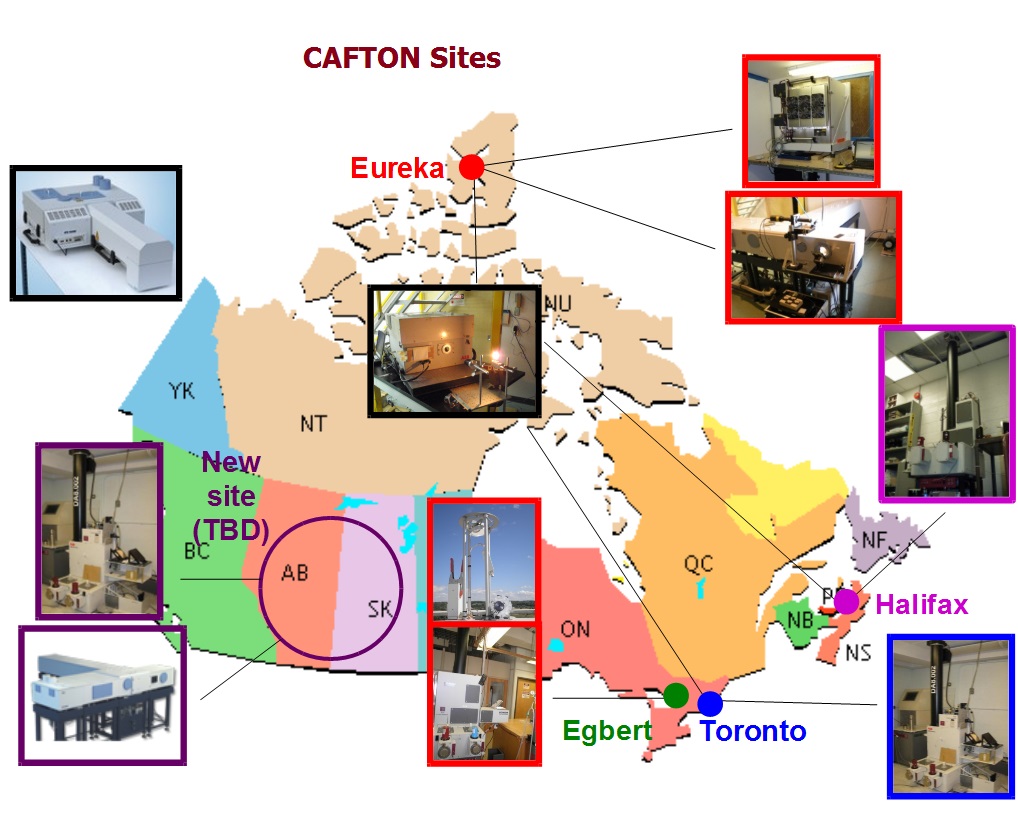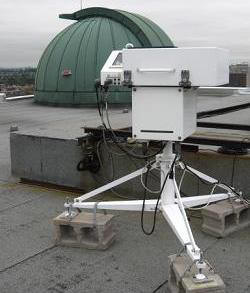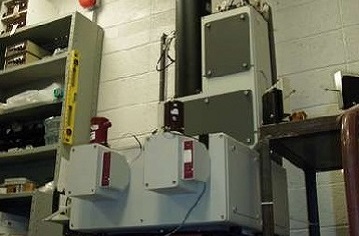| CAFTON | • | Canadian FTIR Observing Network | ||
| CAFTON | • | Canadian FTIR Observing Network | ||
|
Sites and Equipment
CAFTON's four main sites are the University of Toronto Atmospheric Observatory (TAO), the Dalhousie Atmospheric Observatory (DAO), the Polar Environment Atmospheric Research Laboratory (PEARL), and the Centre for Atmospheric Research Experiments (CARE). There are nine ground-based Fourier Transform Infrared (FTIR) Spectrometers currently making or capable of making atmospheric measurements that are a part of CAFTON. Some are located at the main sites, some are mobile instruments and some are yet to be deployed. These instruments are: |
|||
 |
|||
| ABB Inc DA8 FTIR at the University of Toronto Atmospheric Observatory (TAO), Toronto, Ontario | ||||||||||||||||||||||||||||||||||||||||
|
TAO has been operational since October 2001, with regular FTIR
measurements commencing in May 2002. The geographic location of TAO
in downtown Toronto makes it well suited for measurements of
tropospheric pollutants. The TAO DA8 is coupled to a dedicated
altitude-azimuth suntracker (manufactured by AIM Controls Inc.,
California, which is housed in a weatherproof enclosure and
provides continuous active solar tracking throughout the day. The
FTIR is complemented by a commercially available weather station
that records local meteorological variables and by a Brewer
spectrophotometer, on loan from Environment Canada since 2005. Like the other DA8 instruments listed below, this FTIR is a modified Michelson interferometer with a maximum optical path difference of 250 cm, providing a maximum apodized resolution of 0.004 cm-1. It is equipped with KBr and CaF2 beamsplitters, and InSb and HgCdTe (MCT) detectors, for coverage of the spectral range from 750 to 8500 cm-1. The system is also equipped with six narrow-band optical interference filters that are widely used in the NDACC Infrared Working Group. The table below summarizes the trace gases commonly measured with this filter set, both detectors, and the KBr beamsplitter. Built-in globar and quartz halogen sources, as well as an external blackbody, are used during instrument characterization. FTIR solar absorption spectra are recorded under clear sky conditions, allowing for approximately 80-100 observation days per year. Measurements are semi-automated, involving an operator at start up and shut down to engage the suntracker, cool the detectors with liquid nitrogen, and initiate an automatic measurement sequence. Periodic measurements of the instrument lineshape are made using a standard NDACC HBr cell to characterize the phase error and modulation efficiency as a function of optical path difference.
Altitude-dependent volume mixing ratio (VMR) profiles are retrieved from the spectra using SFIT2, a profile retrieval algorithm that employs the Optimal Estimation Method (OEM). The OEM is a regularization method that retrieves VMR profiles from a statistical weighting of the a priori information and the measurements. The averaging kernel matrix produced during the iterative process is used to characterize the information content of the retrievals. The VMR profiles are converted to density profiles using temperature and pressure profiles and integrated to yield the total and partial column densities. The TAO FTIR was certified as an NDACC instrument in 2004 based on the results of a refereed algorithm and data comparison exercise. The quality of the DA8 data was also assessed in a subsequent intercomparison campaign involving two additional lower-resolution FTIR instruments. TAO data have contributed to the validation of SCIAMACHY on Envisat, OSIRIS on Odin, and ACE-FTS and MAESTRO on ACE. The first detection of NO in the mesosphere and lower thermosphere using ground-based FTIR spectroscopy was made using data from TAO and Eureka, and we have investigated the impact of the choice of vertical grid on profile retrievals using FTIR spectra. |
 TAO DA8 TAO Suntracker  TAO Brewer |
|||||||||||||||||||||||||||||||||||||||
| ABB Inc DA8 at the Dalhousie Atmospheric Observatory (DAO), Halifax, Nova Scotia | |||
| The
primary Dalhousie Atmospheric Observatory (DAO) instrument is a
newly refurbished version of the ABB Inc DA8. The spectrometer is
owned by the Canadian Space Agency and the modifications have been
performed at Dalhousie University. This FTIR spectrometer is in the
final phase of commissioning after a complete upgrade of the
electronics and software. Physical changes include the replacement
of the original 16-bit digitizer with a new 18-bit model, thus
avoiding the need for an undesirable gain switch during scans. Plans
are in hand to convert to a 24-bit DC uniform-time sampling system. Halifax is ideally situated to monitor the pollution outflow from northeast North America because for much of the time it is under the outflow from the region. Beginning in March 2011, solar absorption measurements covering the spectral range 2000-4500 cm-1 have been made on a regular basis using a CaF2 beamsplitter and InSb detector. In June 2011 this range was expanded to 750 cm-1 with the use of a KBr beamsplitter and MCT detector. As part of the electronic upgrade, fully scriptable control software has been developed enabling the complete automation of the measurement routine. An operator is still required at the start of each day to cool the detectors, but otherwise operation is autonomous. The software provides great transparency and control over the analysis of the data by treating every scan independently and (if necessary) co-averaging the resulting spectra. A newly designed altitude/azimuth suntracker built to support the DA8 has been operating successfully at DAO since June 2010. The primary tracking algorithm is based on ephemeris calculations thereby minimizing the effects of a temporary loss of signal due to a passing cloud. This passive mode is supplemented by an active correction routine whereby a small portion of the solar beam is directed to a camera. Careful monitoring of the solar disc's position enables corrections to be made to the tracking as well as providing a quantitative measure of the tracking accuracy as a function of time. An identical tracker was installed in Eureka, NU, in June 2013 to support FTS measurements made at PEARL. The spectra gathered at DAO are currently converted into the desired partial columns of trace gases using SFIT2 software. However, efforts are underway to begin using the newer SFIT4 software package. |
 DAO DA8 DAO Suntracker |
||
|
ABB Inc DA8 at
Environment Canada's Centre for Atmospheric Research Experiments
(CARE), Egbert, Ontario The CARE DA8 is similar in its capabilities to the TAO DA8. It is generally operated semi-remotely from Downsview, requiring local assistance with LN2 detector filling and suntracker activation. Operation is facilitated by the presence of a sky camera, permitting the operator in Downsview to evaluate and monitor cloud conditions. It is equipped with MCT and InSb detectors and KBr, CaF2, and KCl beamsplitters. It is also equipped with NDACC filters and while not an NDACC instrument, its data record has been used on occasion in NDACC-related studies. The current suntracker is a University of Denver model. CARE is located approximately 70 km northwest of the main Environment Canada Experimental Studies Laboratories in Downsview and approximately 80 km northwest of TAO, in a rural setting outside of most of the localized Toronto urban pollution. As such it presents an interesting contrast to tropospheric measurements at TAO. As CARE is a major Environment Canada research centre, a number of complementary measurement programs are located there. Among them are the Canadian Sunphotometry Network (AEROCAN), the Greenhouse Gases Program, and the National Air Pollution Surveillance Network (NAPS). CARE is also home to the EC Experimental Studies lidar group, which operates a DIAL system as well as a CORALnet lidar. |
||
| The Bruker IFS 125HR at the Polar Environment Atmospheric Research Laboratory (PEARL), Eureka, Nunavut | ||||
| PEARL was
established in 2005 by CANDAC. It is located on Ellesmere Island at
Eureka (80.05ºN, 86.42ºW), 610 m above sea level. The facility is
home to more than 25 instruments that making comprehensive
measurements of the atmosphere from the ground to 100 km. The Bruker 125HR FTIR is a high-resolution spectrometer that runs semi-autonomously, recording solar absorption spectra throughout the sunlit part of the year (mid-February to mid-October). This FTIR also uses a sequence of seven narrow-band interference filters covering the mid-infrared spectral range (600-4300 cm1 at 0.0035 cm1 unapodized resolution), while measuring with either an InSb or MCT detector with a KBr beamsplitter. The spectral measurements from this instrument have been analysed using the SFIT2 spectral fitting code to obtain total and partial columns of species such as O3, NO, NO2, HNO3, ClONO2, HCl, OClO, HF, N2O, CFCs, CO, CO2, CH4, C2H6, HCN, and OCS. |
||||
| The capabilities of the instrument were enhanced in September 2009, with the installation of a new InGaAs detector and HCl cell to enable the recording of near-infrared spectra from 3800-11000 cm-1, a region that can be used for the retrieval of CO2 and O2 columns. This upgrade was motivated by the objectives of joining TCCON and contributing to validation of CO2 measurements made by GOSAT and ACE. At the annual TCCON science team meeting, held in Australia in June 2010, the PEARL Bruker FTS was confirmed as a new network instrument, one of only three in the Arctic and the first in Canada. Since the upgrade, the CANDAC operators have been alternating between mid-infrared and near-infrared measurements, as a manual beamsplitter change is required for each dataset. TCCON has developed an analysis protocol for CO2, O2, CH4, N2O, HF and CO, and all sites use the same GGG/GFIT retrieval code. |
PEARL Bruker IFS 125HR |
|||
|
ABB Inc
Extended-range Atmospheric Emitted Radiance Interferometer (E-AERI)
at PEARL, Eureka, Nunavut The CANDAC E-AERI was installed at the PEARL Ridge Lab in October 2008, where it made measurements in parallel with the Polar-AERI (P-AERI) instrument on loan from Von Walden (U Idaho) through the Study of Environmental Arctic Change (SEARCH) group in the US until the P-AERI was removed in July 2009. The E-AERI was subsequently moved to the Zero-altitude PEARL Auxiliary Lab (ØPAL) in September 2009, to ensure ongoing emission measurements from sea level. The E-AERI consists of a Fourier transform spectrometer with 1 cm-1 resolution. It measures the infrared thermal emission of the atmosphere, rather than high-resolution solar absorption spectra. One measurement cycle includes a sky measurement as well as calibration measurements of two internal blackbodies to ensure accurately calibrated spectra. Measurements are independent of sun- or moon-light and are only interrupted during precipitation events to prevent damage of the optics. The thermal emitted radiance is primarily dependent on water vapour and temperature, allowing temperature and humidity profiles of the planetary boundary layer to be derived from the spectra. It records infrared emission spectra from 400-3300 cm-1 (3-25 μm) every ~10 minutes, including night and cloudy days, thus providing year-round measurements, including polar night. This provides coverage of the 20-micron “dirty window” of the atmospheric absorption spectrum, where infrared cooling primarily occurs and which is present only at polar latitudes due to the inherently low abundance of water vapour there. |
||
|
Portable
Atmospheric Research Interferometric Spectrometer for the Infrared
(PARIS-IR) PARIS-IR is a portable FTIR spectrometer built by ABB Inc for atmospheric remote sounding from the ground and airborne platforms such as high-altitude balloon gondolas. It is based at the University of Toronto but has been deployed on various field campaigns. It was constructed as a terrestrial version of the ACE-FTS using a similar design and incorporating flight-spare optical components from the satellite instrument. It is capable of running autonomously for several hours using a batch file to control the instrument operations. The spectrometer records double-sided interferograms with the same ±25 cm maximum optical path difference (corresponding to a 0.02 cm-1 resolution – calculated by 0.5/MOPD) as the ACE-FTS. PARIS-IR has two detectors (MCT and InSb), mounted in a sandwich arrangement, that measure the full 750-4400 cm-1 spectral range during each acquisition. This allows PARIS-IR to determine total columns of all target species from each spectral measurement taken throughout an observing day (with suitable weather conditions). These spectra have been analyzed with SFIT2 to obtain total column amounts for O3, HCl, HF, HNO3, CH4, and N2O. Retrievals are being developed for additional species such as H2O, NO, NO2, and CFCs. |
||
|
Mobile Bruker 125M The Experimental Studies group of the Science and Technology Branch at Environment Canada has recently developed what is commonly referred to as a long-path system. In this arrangement, a Bruker IFS 125M FTIR (capable of 0.008 cm-1 resolution but operated at 0.1 cm-1) measures an infrared signal that is produced at the instrument and projected horizontally towards a retro-reflector some distance away. The return beam is collected by a 12-inch Ritchey-Cassegrain telescope and focused into the FTIR. At the input of the telescope is a steerable mirror that allows selection of different targets. The FTIR is equipped with InSb and MCT detectors as well as KBr and CaF2 beamsplitters. This geometry is designed to provide very sensitive measurements of boundary layer constituents over paths in the thousands of meters in length. In particular, this technique has been applied to the measurement of CH4 and N2O, and to the detection of biomass burning products. It is often employed with a white cell arrangement, which makes for a more compact setup but limits the detection area to the atmosphere in the immediate vicinity. While located in Downsview during its development, this is a mobile instrument and as such will travel at the very least to PEARL to make measurements, and could also travel to the other sites. The instrument can also be fitted with a suntracker enabling solar measurements to be taken in addition to the long-path work. |
||
| Bruker
IFS 125HR A second Bruker IFS 125HR, similar in most respects to that located at PEARL and described above, is also associated with CAFTON. CAFTON is currently in the process of developing a new site in Western Canada to increase the coverage of FTIR atmospheric measurements across the country. This site will likely be in Alberta or Saskatchewan and once it has been established the second Bruker IFS 125HR will be located there. |
||
|
ABB Inc DA8 FTIR The fourth CAFTON ABB Bomom DA8 FTIR spectrometer was previously installed at Eureka, where it was operated during spring, and some fall periods, by EC from 1993 to 2008. It was an NDACC instrument during this time, and was used to certify the new Bruker FTIR as its replacement. It was removed from Eureka in February 2009, and has been refurbished by the Dalhousie group in a manner similar to their Canadian Space Agency DA8. In the near future it will be deployed at the new CAFTON site in Western Canada. |
||